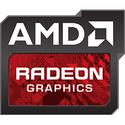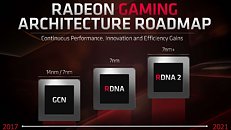Friday, December 13th 2019

Ray Tracing and Variable-Rate Shading Design Goals for AMD RDNA2
Hardware-accelerated ray tracing and variable-rate shading will be the design focal points for AMD's next-generation RDNA2 graphics architecture. Microsoft's reveal of its Xbox Series X console attributed both features to AMD's "next generation RDNA" architecture (which logically happens to be RDNA2). The Xbox Series X uses a semi-custom SoC that features CPU cores based on the "Zen 2" microarchitecture and a GPU based on RDNA2. It's highly likely that the SoC could be fabricated on TSMC's 7 nm EUV node, as the RDNA2 graphics architecture is optimized for that. This would mean an optical shrink of "Zen 2" to 7 nm EUV. Besides the SoC that powers Xbox Series X, AMD is expected to leverage 7 nm EUV for its RDNA2 discrete GPUs and CPU chiplets based on its "Zen 3" microarchitecture in 2020.
Variable-rate shading (VRS) is an API-level feature that lets GPUs conserve resources by shading certain areas of a scene at a lower rate than the other, without perceptible difference to the viewer. Microsoft developed two tiers of VRS for its DirectX 12 API, tier-1 is currently supported by NVIDIA "Turing" and Intel Gen11 architectures, while tier-2 is supported by "Turing." The current RDNA architecture doesn't support either tiers. Hardware-accelerated ray-tracing is the cornerstone of NVIDIA's "Turing" RTX 20-series graphics cards, and AMD is catching up to it. Microsoft already standardized it on the software-side with the DXR (DirectX Raytracing) API. A combination of VRS and dynamic render-resolution will be crucial for next-gen consoles to achieve playability at 4K, and to even boast of being 8K-capable.
Variable-rate shading (VRS) is an API-level feature that lets GPUs conserve resources by shading certain areas of a scene at a lower rate than the other, without perceptible difference to the viewer. Microsoft developed two tiers of VRS for its DirectX 12 API, tier-1 is currently supported by NVIDIA "Turing" and Intel Gen11 architectures, while tier-2 is supported by "Turing." The current RDNA architecture doesn't support either tiers. Hardware-accelerated ray-tracing is the cornerstone of NVIDIA's "Turing" RTX 20-series graphics cards, and AMD is catching up to it. Microsoft already standardized it on the software-side with the DXR (DirectX Raytracing) API. A combination of VRS and dynamic render-resolution will be crucial for next-gen consoles to achieve playability at 4K, and to even boast of being 8K-capable.

119 Comments on Ray Tracing and Variable-Rate Shading Design Goals for AMD RDNA2
*) They would have to scale it a little back to avoid too high power consumption.
AMD's RDNA2 seems to go and follow the same general idea as Nvidia did - small specialized ASIC added to existing pipeline, in RDNA2 reportedly next to or in the TMUs.
Control was beautiful but still played like a demo with DLSS at 55-62 fps.I want steady 70 fps at native with a $600 prie tag max.
, Physx, the evolution of DX, Tessellation, all things that needed a generation to become useable and another one to become features we now take for granted and are just standard settings we don’t even think about anymore effecting our performance.
remember how expensive gtx 8800 was ?
it was a breakthrough card nevertheless.
now we've got rtx 2060 running circles around 1080Ti in ray tracing.
GTX 1080 Ti received a lot of harsh criticism when it launched, then Turing came along and all of a sudden GTX 1080 Ti was excellent and Turing bad.
Also, AMD criticized ray tracing when Turing launched, and now they may be launching something similar next year (if rumors are to be believed).
As always, the perspective changes to fit the ever-changing narrative.
From rumors and leaks, RDNA2 places RT ASIC into TMU. This should lead to an interesting situation where AMD has more RT capabilities assuming their unit has similar capabilities to Nvidia's RT Cores (which, based on AMD's patent is very likely). RX 5700XT has 160 TMUs while RTX 2080 Super has 48 SMs/RT Cores (Turing has one RT Core per SM).
Also keep in mind that "RDNA2" will mostly compete with the next generation from Nvidia.
steamcommunity.com/games/673130/announcements/detail/1696100248040858937